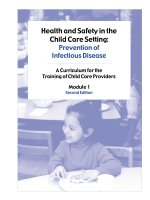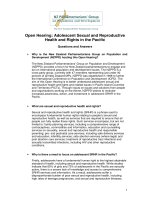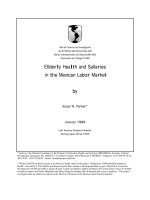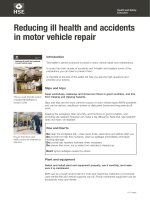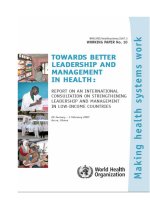Reducing ill health and accidents in motor vehicle repair pot
Bạn đang xem bản rút gọn của tài liệu. Xem và tải ngay bản đầy đủ của tài liệu tại đây (2.35 MB, 9 trang )
Health and Safety
Executive
1 of 7 pages
Health and Safety
Executive
Reducing ill health and accidents
in motor vehicle repair
This is a web-friendly version
of leaflet INDG356(rev1),
revised 12/09
Reducing ill health and accidents
in motor vehicle repair
Introduction
This leaflet is aimed at anyone involved in motor vehicle repair and maintenance.
It covers the main causes of accidents and ill health and explains some of the
precautions you can take to prevent them.
A checklist at the end of the leaflet will help you ask the right questions and
prioritise your actions.
Slips and trips
Keep workshops, walkways and showroom floors in good condition, and free
from tripping and slipping hazards.
Slips and trips are the most common cause of motor vehicle repair (MVR) accidents
and can be serious, resulting in broken or dislocated bones and long periods off
work.
Keeping the workplace clean and tidy, and the floors in good condition, and
providing slip-resistant footwear can make a big difference. Note that ‘slip-resistant’
does not mean ‘oil-resistant’.
Dos and Don’ts
Do keep the workplace tidy – clear away tools, used items and airlines after use.
Do provide non-slip floor surfaces. Clear up spillages immediately and repair
flooring damage.
Do provide slip-resistant footwear when necessary.
Do ensure that snow, ice or water from vehicles is cleaned up.
Don’t ignore spillages caused by others.
Plant and equipment
Select and install plant and equipment properly, use it carefully, and make
sure it is maintained.
MVR can be a tough environment for tools and machinery. Defective or incorrectly
used vehicle lifts and vehicle supports can kill. Poorly maintained equipment can be
excessively noisy and vibrate.
Ensure that floors and
traffic routes are cleaned as
required
2 of 9 pages
Health and Safety
Executive
Reducing ill health and accidents in motor vehicle repair
The risk from a vehicle lifted or supported off the ground is often underestimated
and causes fatal accidents, for example as a result of:
poorly maintained, overloaded or incorrectly positioned lifting equipment; ■
vehicles supported only on jacks; ■
vehicles being lifted on sloping or unstable ground; ■
wheel chocks not used with axle stands; ■
wrong pins in axle stand extensions; or ■
unsafe props or no props used with HGV bodies and trailers. ■
The unsafe use of machinery such as grinding wheels, pedestal drills and
compressors causes many injuries. Vibrating, hand-held power tools can damage
bones and joints.
Dos and Don’ts
Do ensure that all equipment is installed, used, regularly inspected and
maintained as recommended by the manufacturer.
Do train people to use equipment and machinery correctly.
Do buy and use reduced-vibration tools wherever possible and maintain them.
Don’t use machines and equipment unless the correct safeguards are in
position (eg guards and rests on grinding wheels, chuck and drill guards on
pedestal drills, drive belts guarded on compressors, toe protection on vehicle
lifts, and original specification support pins on axle stands).
Don’t use any vehicle lifts, lifting plant/equipment or compressors unless they
have a valid certificate of inspection and thorough examination from a competent
person.
Manual handling
Identify safe methods for handling heavy/bulky items.
Manual handling means lifting, carrying, supporting or moving heavy or bulky loads
by hand or bodily force. It causes nearly a third of all accidents in MVR.
Avoid manual handling where there is a risk of injury, but where this is not possible,
take sensible precautions to reduce the risk.
Dos and Don’ts
Do consult the workforce because they will be familiar with handling problems
and may have practical solutions to them.
Do provide mechanical aids where appropriate, eg engine hoists, trolleys for
tyres and gas cylinders, and train people to use them correctly.
Do encourage staff to ask others to help them with awkward or heavy loads.
Don’t let people struggle.
Always use axle stands if
working beneath a vehicle
raised on a jack
A gas cylinder trolley
3 of 9 pages
Health and Safety
Executive
Reducing ill health and accidents in motor vehicle repair
Falls
Provide precautions for working areas where people could fall a distance that
could injure them.
These are the most common cause of death or serious injury to people at work. (In
MVR they account for nearly 10 per cent of injuries, mainly involving falls from ladders.)
The main areas of concern are:
falls from raised storage areas, moveable ladders or HGV and trailer units under ■
repair; and
falls into inspection pits. ■
Dos and Don’ts
Do take appropriate precautions to stop people falling into pits.
Do provide suitable access for work at height.
Do check ladders, steps, platforms and scaffolding – record your findings.
Don’t use ladders that are unsecured or on uneven/unstable ground.
Don’t allow people to climb racking to get parts.
Don’t use faulty access equipment – get it repaired or replaced.
Transport
Vehicle movements are a serious risk, particularly in cramped or busy
premises, so make sure they are managed correctly.
Transport accidents often involve vehicles reversing or moving unintentionally, for
example if they:
are ■ started in gear with the handbrake off;
roll down a slope; or ■
are ■ moved away when someone is working underneath them.
Such accidents can result in fatal injuries to both employees and customers.
MVR will always involve vehicle movement so segregation of vehicles from people is
important.
Dos and Don’ts
Do keep vehicles and pedestrians apart, provide safe parking for customers and
reduce the need for reversing.
Do provide an adequate number of traffic routes, of sufficient width and
headroom, to allow people and vehicles to circulate safely with ease.
Do make a plan of the work area – identify parking and loading areas and
directions of travel.
Don’t leave vehicles unbraked or unchocked, eg when on vehicle lifts or sloping
ground.
Don’t start the engine from outside the vehicle. Always start vehicles from the
driver’s seat with both feet inside and the gear disengaged.
A pivoting safety barrier
ensures the fence opening is
guarded at all times
This site entrance has a
segregated walkway and a
marshal for directing traffic
4 of 9 pages
Health and Safety
Executive
Reducing ill health and accidents in motor vehicle repair
Fire and explosion
Always treat fuel and flammable materials with respect. Incidents involving
fire and explosion can cause burns, death and property damage.
Fire and explosion incidents in MVR are mainly caused by:
mishandling petrol; ■
grinding, cutting or welding near fuel tanks/lines, brake pipes or other flammable ■
materials; and
mishandling or misuse of flammable liquids such as degreasers or thinners. ■
Incorrect storage or use of gas cylinders may cause incidents and can also make
them much worse.
Dos and Don’ts
Do use a proprietary fuel retriever/adaptor when draining petrol from tanks and
lines – make sure the vehicle and the retriever are both earthed.
Do keep the tops/lids on containers of highly flammable liquids.
Do store containers of highly flammable liquids in a safe place, in the open air or
in a suitable storeroom.
Do fit flashback arresters to both the fuel and oxygen gas cylinder regulators. For
longer lengths of hose, also fit them to the blowpipe.
Do store gas cylinders in a safe, well-ventilated space, preferably outside.
Don’t drain petrol over, or close to, a pit or drain.
Don’t smoke, weld or carry out other hot work while removing petrol.
Don’t store more than 50 litres of highly flammable liquids in the workroom.
Don’t spray highly flammable liquid paints in the open workshop or where there
is a risk of fire/explosion.
Don’t use petrol/solvents to burn rubbish.
Don’t carry out hot work before removing or shielding items that may be affected.
Electrical safety
Make sure electrical equipment is installed and maintained correctly – take
particular care in wet or potentially explosive areas.
The combination of trailing leads, vehicle movements and contamination (by oil, fuel,
solvents, water etc) can cause damage to portable electrical equipment. Minimise the
use of portable mains-voltage equipment and visually check and test it regularly.
Dos and Don’ts
Do have the fixed electrical system checked (recommended at least every five
years) by a competent electrician and keep records of the results.
Do use air-tools or cordless or low-voltage (110 v or 50 v) equipment wherever
possible.
Do use residual current device (RCD) protection for each electrical socket.
Do visually check portable tools, eg hand lamps, drills and grinders, before use
and have them tested regularly by a competent person.
Don’t use a pressure washer without an RCD or earth-monitoring device, which
should be tested every day.
A fuel retriever showing
mechanical pump and
earthing cables
RCD protection provided for
portable vacuum cleaner
5 of 9 pages
Health and Safety
Executive
Reducing ill health and accidents in motor vehicle repair
Skin disease
Repairing vehicles can be dirty work so avoid skin contact if possible and
provide cleaning facilities for workers.
Dermatitis is common in MVR and disease rates are up to seven times the average
for UK workers. Symptoms can be so severe that sufferers have to leave the
industry. Common causes in garages include chemicals in two-part glues, body
fillers and sealants.
Other materials such as oils, solvents, fuels and abrasive materials cause dermatitis
through irritation or drying out of the skin. There is evidence to suggest that used
engine oils can cause skin cancer.
Risks of skin disease can be reduced by taking the ‘avoid, protect, check’
approach:
Avoid ■ contact, eg provide local exhaust ventilation (LEV) for sanding, and use
automatic dispensers for two-part glues.
Protect ■ skin: use single-use, nitrile or low-protein, non-powdered latex gloves, use
the mildest skin cleaner that works, and use after-work creams.
Check ■ for early signs of dermatitis wherever there is a risk, by encouraging self-
reporting of skin problems and by appointing a responsible person (supported
by a health professional) to carry out skin checks.
Dos and Don’ts
Do use the right type of disposable glove to keep the hands clean, eg nitrile for
oils and grease.
Do make sure washing facilities have running hot and cold or warm water, soap
and clean towels or other means of cleaning or drying.
Do provide dispensers for pre-work creams, cleansers and after-work creams so
workers will be more likely to use them.
Don’t use cleaners that are too strong as these can damage the skin.
Want to know more?
Health and safety in motor vehicle repair and associated industries HSG261
HSE Books 2009 ISBN 978 0 7176 6308 8
Preventing slips and trips at work Leaflet INDG225(rev1) HSE Books 2005 (single
copy free or priced packs of 15 ISBN 978 0 7176 2760 8)
www.hse.gov.uk/pubns/indg225.pdf
Using work equipment safely Leaflet INDG229(rev1) HSE Books 2002 (single copy
free or priced packs of 10 ISBN 978 0 7176 2389 1)
www.hse.gov.uk/pubns/indg229.pdf
Control the risks from hand-arm vibration: Advice for employers on the Control of
Vibration at Work Regulations 2005 Leaflet INDG175(rev2) HSE Books 2005 (single
copy free or priced packs of 10 ISBN 978 0 7176 6117 6)
www.hse.gov.uk/pubns/indg175.pdf
Wearing nitrile gloves
reduces hand contamination
6 of 9 pages
Health and Safety
Executive
Reducing ill health and accidents in motor vehicle repair
Getting to grips with manual handling: A short guide Leaflet INDG143(rev2)
HSE Books 2004 (single copy free or priced packs of 10 ISBN 978 0 7176 2828 5)
www.hse.gov.uk/pubns/indg143.pdf
Workplace transport safety: An overview Leaflet INDG199(rev1) HSE Books 2005
(single copy free or priced packs of 5 ISBN 978 0 7176 2821 6)
www.hse.gov.uk/pubns/indg199.pdf
Safe use of petrol in garages Leaflet INDG331 HSE Books 2000 (single copy free or
priced packs of 10 ISBN 978 0 7176 1836 1) www.hse.gov.uk/pubns/indg331.pdf
Electrical safety and you Leaflet INDG231 HSE Books 1996 (single copy free or
priced packs of 15 ISBN 978 0 7176 1207 9) www.hse.gov.uk/pubns/indg231.pdf
Do you use a steam/water pressure cleaner? You could be in for a shock! Leaflet
INDG68(rev) HSE Books 1997 (single copy free) www.hse.gov.uk/pubns/indg68.pdf
Preventing contact dermatitis at work Leaflet INDG233(rev1) HSE Books 2007
(single copy free or priced packs of 15 ISBN 978 0 7176 6183 1)
www.hse.gov.uk/pubns/indg233.pdf
Safe working with vehicle air-conditioning systems: Guidance for employers, self-
employed people, and supervisors Leaflet INDG349 HSE Books 2002 (single copy
free or priced packs of 10 ISBN 978 0 7176 2278 8)
www.hse.gov.uk/pubns/indg349.pdf
Safe working with LPG-fuelled motor vehicles Leaflet INDG387 HSE Books 2003
(single copy free or priced packs of 10 ISBN 978 0 7176 2755 4)
www.hse.gov.uk/pubns/indg387.pdf
Advice on HSE’s website
You can find extensive health and safety advice for the motor vehicle repair
industries at: www.hse.gov.uk/mvr.
Further information on specific topics can be found at the web links below.
Slips and trips: www.hse.gov.uk/slips
Plant and equipment: www.hse.gov.uk/equipment
Manual handling: www.hse.gov.uk/msd
Falls: www.hse.gov.uk/falls
Transport: www.hse.gov.uk/workplacetransport
Fire and explosion: www.hse.gov.uk/fireandexplosion
Electrical safety: www.hse.gov.uk/electricity
Skin disease: www.hse.gov.uk/skin
7 of 9 pages
Health and Safety
Executive
Reducing ill health and accidents in motor vehicle repair
Checklist for safe mechanical repair and servicing
Slips and trips
Are workshops, walkways and showroom floors in good condition,
and free from tripping and slipping hazards?
Are all floors cleaned regularly?
Are spillages cleared immediately and snow, ice and water from
vehicles cleaned up?
Is there non-slip flooring where appropriate?
Are employees issued with non-slip footwear where necessary?
Plant and equipment
Is all equipment maintained and regularly inspected as recommended
by the manufacturer?
Are reduced-vibration tools used wherever possible?
Is all machinery guarding in place and in good condition?
Are all vehicles properly supported before anyone works underneath
them?
Are correct props used with HGV cabs, bodies and trailers?
Are axle stands fitted with original specification pins?
Do vehicle lifts have toe protection and hinged end-stops?
Are arm-locking devices on two-post lifts checked daily and arms
positioned carefully before each lift?
Does all lifting equipment and the air compressor have a valid
certificate of inspection and thorough examination from a competent
person?
Are vehicle supports inspected every year?
Manual handling
Are appropriate mechanical aids for heavy or bulky items such as
tyres, gas cylinders, engine blocks etc used correctly?
Is assistance for moving heavy or bulky items available when required?
Questions you should ask Yes/No
8 of 9 pages
Health and Safety
Executive
Reducing ill health and accidents in motor vehicle repair
Falls
Are there appropriate precautions for working areas such as pits,
mezzanine floors, racking, on top of vehicles etc?
Is there suitable, secured access from level and stable ground?
Are ladders and other access equipment checked regularly and
repaired or replaced if faulty?
Transport
Is there a plan of the work area with parking, loading and directions of
travel marked out?
Do vehicles and pedestrians have separate, clearly marked routes as
far as possible?
Has reversing been reduced to a minimum?
Are vehicles always braked and chocked, particularly on lifts and
sloping floors?
Are vehicles started correctly (ie from the driver’s seat with both feet
inside and the gear disengaged)?
Fire and explosion
If petrol has to be drained, is a proprietary fuel retriever used and are
the necessary precautions followed?
Are ignition sources (eg smoking, welding, grinding) excluded when
working with or near highly flammable substances?
Are vulnerable items removed or shielded before hot work (welding,
grinding, cutting etc)?
Are flammable liquid containers kept closed?
Are gas cylinders stored in a safe, well-ventilated place (preferably
outdoors)?
Is there an adequate flammable liquids store or storage in the
open air?
Are flash arresters fitted to both the fuel and oxygen gas cylinder
regulators?
Are less than 50 litres of highly flammable liquid stored in the
workroom?
Are waste fuel and flammable solvents stored and disposed of safely?
Questions you should ask Yes/No
9 of 9 pages
Health and Safety
Executive
Questions you should ask Yes/No
Electrical safety
Is the current (ie within the last five years) electrician’s report available
for the fixed electrical system?
Are low-voltage tools used where possible?
Are other portable electric tools visually checked before use and tested
regularly by a competent person?
Is there an RCD or earth-monitoring device fitted to the pressure
washer supply that is tested daily?
Skin disease
Is the right type of disposable gloves used?
Are there running hot and cold or warm water, soap and clean towels
or similar?
Are there dispensers for pre-work creams, cleansers and after-work
creams?
Do employees know who they should report early signs of dermatitis to?
Further information
For information about health and safety, or to report inconsistencies or inaccuracies
in this guidance, visit www.hse.gov.uk/. You can view HSE guidance online and
order priced publications from the website. HSE priced publications are also
available from bookshops.
This leaflet contains notes on good practice which are not compulsory but
which you may find helpful in considering what you need to do.
This leaflet is available in priced packs of 10 from HSE Books,
ISBN 978 0 7176 6376 7. Single copies are free and a web version can be found at
www.hse.gov.uk/pubns/indg356.pdf.
© Crown copyright If you wish to reuse this information visit www.hse.gov.uk/
copyright.htm for details. First published 12/09.
Published by the Health and Safety Executive INDG356(rev1) 09/11


